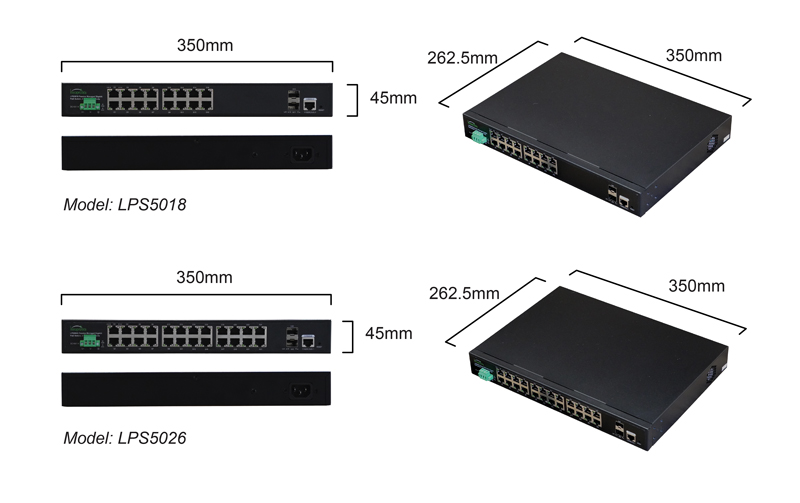LinkPower LPS5018 / LPS5026 Managed Gigabit Passive PoE Switch Series is a full gigabit managed passive PoE fiber switch. It has 16 and 24 10/100/1000M RJ45 ports and 2 1000M SFP slot ports. Port 1-16 can support 24V/48V non-stan- dard PoE. Port 1-4 single port PoE power reaches 36W/72W, port 5-16 PoE power reaches 18W/36W, and the maximum PoE output power is 250W for LPS5018 and 400W for LPS5026. A non-standard, i.e., passive, PoE power supply device must be connected to the corresponding non-standard, i.e., passive, electrical equipment (such as a wireless bridge, building visual access control intercom, etc.) or the corresponding non-standard separation line to convert and achieve the PoE power supply. LPS5018 / LPS5026 can supply power to various adaptable terminals through network cables to meet the demand for a high-density PoE network environment.
KEY SYSTEM FEATURES
- All series support the "gigabit Ethernet port and gigabit SFP fiber port" combination, enabling users to build networking to meet the needs of various scenarios flexibly.
- Support full-duplex based on IEEE802.3x and half-duplex based on backpressure.
- Power redundancy: Built-in power supply & external DC power input
- 16*10/100/1000Base-T RJ45 ports, meeting the needs of security monitoring, teleconferencing system, wireless coverage, and other scenarios.
- 1-4 port, the max power supply of a single port is 36W/72W, and the max power supply of a single port is 18W/36W.
Note: The voltage of each port is adjustable based on a non-standard passive PoE. It powers the load directly. - It can quickly realize the power supply function of POE cable by switching directly to non-standard electrical equipment or switch and non-standard separation lines.
- With the support of IEEE 802.1Q VLAN and protocol VLAN, users can flexibly divide VLAN according to needs. Ring network STP/RSTP spanning tree protocol eliminates layer two loops and realizes link backup.
- Support QoS, three priority modes based on port, 802.1P-based and DSCP-based, and four queue scheduling algorithms: Equ, SP, WRR, and SP+WRR.
- Support ACL in filtering data packets by configuring matching rules, processing operations, and time permissions to provide flexible security access control strategies.
- Support IGMP V1/V2 multicast protocol and IGMP Snooping to meet the needs of multi-terminal high-definition video surveillance and video conferencing access.
- Static aggregation and dynamic aggregation effectively increase link bandwidth, achieve load balancing and link backup, and improve link reliability.
- CPU monitoring, memory monitoring, Ping detection, cable detection. SSH V1/V2 and other encryption methods make management more secure.
- System logs and port traffic statistics facilitate network optimization and transformation.
- LLDP facilitates the network management system by querying and determining the communication status of the link.
- Web network management, CLI (Console, Telnet), SNMP (V1/V2/V3), and other diversified management and maintenance methods.









